Improving Social Acceptance of Orthopedic Foot Orthoses Through Image-Generative AI in Product Design
Abstract
:1. Introduction
- RQ1: How does the use of AI-generated designs impact the perceived social acceptability of foot orthoses compared to conventional orthopedic products or research developments?
- RQ2: How does the category of orthotic products influence the social acceptance of foot orthoses, comparing categories such as short-leg orthoses, high-leg orthoses, foot bandages/textiles, and foot drop orthoses?
- RQ3: How does a custom generative pre-trained transformer (GPT), trained on data for personalized orthoses, impact social acceptance, and what effect do specific keywords in the prompt structure (such as “social acceptance” or “sporty design”) have on this acceptance?
- We introduce a novel approach that leverages image-generative AI to enhance the customization and aesthetic appeal of foot orthosis designs, increasing their alignment with user requirements and visual attractiveness.
- Our research provides empirical evidence demonstrating that AI-generated orthosis designs significantly enhance social acceptability among users. This potential could be utilized to create widely accepted design solutions for other products as well.
- We offer a comprehensive set of future recommendations for integrating AI into the orthotic design, aiming to refine the prompt design process to ensure that the resulting designs meet product requirements and patient design expectations.
2. Related Work
2.1. Generative AI: Image-to-Image and Text-to-Image Creation
2.2. Generative AI in Product Design
2.3. Influence of Design on the Social Perception of Wearable Devices
2.4. Research Gaps
3. Materials and Methods
3.1. Study 1: The Impact of AI-Generated and Conventional Orthotic Designs Across Device Categories on Social Acceptability
3.1.1. Study Design
3.1.2. Stimuli
3.1.3. Procedure
3.1.4. Measures and Data Analysis
Quantitative: Stereotype Content Model (SCM)
Quantitative: Wearable Acceptability Range (WEAR)
Quantitative: 7-Point Likert Scales
Qualitative Feedback
3.2. Study 2: The Impact of GPT Customization and Prompt Keywords on the Social Acceptability of AI-Generated Orthotic Designs
3.2.1. Study Design
3.2.2. Stimuli
- Product specifications: Detailed information on the aesthetic and functional aspects of high-leg orthoses, such as material types, sizes and weight from data sheets and guidelines.
- Usage instructions: Documents with instructions and user manuals for the use and maintenance of these devices.
- Product images: Sample images of high-leg orthoses from various suppliers as a visual reference for a realistic design.
- Research articles: Related articles providing insights into product design rules, the concepts of accessibility/usability, and orthotic development were searched on Google Scholar.
- Keyword definitions: Documents based on international standards and dictionary definitions provided explanations about the three keywords (usability, social acceptability, and sport design) to guide the AI in generating contextually relevant content.
3.2.3. Procedure
3.2.4. Measures and Data Analysis
4. Results
4.1. Study 1
4.1.1. Participants
4.1.2. Quantitative Results
Correlation of SCM and WEAR Ratings
Stereotype Content Model (SCM)
Wearable Acceptability Range (WEAR)
Seven-Point Likert Scale
4.1.3. Qualitative Feedback
4.2. Study 2
4.2.1. Participants
4.2.2. Quantitative Results
Correlation of SCM and WEAR Ratings
Stereotype Content Model (SCM)
Wearable Acceptability Range (WEAR)
Seven-Point Likert Scale
4.2.3. Qualitative Feedback
5. Discussion
5.1. The Impact of AI-Generated and Conventional Orthotic Designs Across Device Categories on Social Acceptability
5.2. The Impact of GPT Customization and Prompt Keywords on the Social Acceptability of AI-Generated Orthotic Designs
5.3. Implications
5.4. Limitations
5.5. Future Work
6. Conclusions
Author Contributions
Funding
Institutional Review Board Statement
Informed Consent Statement
Data Availability Statement
Acknowledgments
Conflicts of Interest
References
- Mohaddis, M.; Maqsood, S.A.; Ago, E.; Singh, S.; Naim, Z.; Prasad, S. Enhancing Functional Rehabilitation Through Orthotic Interventions for Foot and Ankle Conditions: A Narrative Review. Cureus 2023, 15, e49103. [Google Scholar] [CrossRef]
- Slater, G.; Slater, T. Current concepts review: Orthotics in post-operative foot and ankle surgery. J. Regen. Biol. Med. 2022, 4, 1–4. [Google Scholar] [CrossRef] [PubMed]
- Surmen, H.K.; Akalan, N.E.; Arslan, Y.Z. Design, manufacture, and selection of ankle-foot-orthoses. In Advanced Methodologies and Technologies in Artificial Intelligence, Computer Simulation, and Human-Computer Interaction; IGI Global: Hershey, PA, USA, 2019; pp. 250–266. [Google Scholar]
- Leite, M.; Soares, B.; Lopes, V.; Santos, S.; Silva, M.T. Design for personalized medicine in orthotics and prosthetics. Procedia CIRP 2019, 84, 457–461. [Google Scholar] [CrossRef]
- Ghoseiri, K.; Bahramian, H. User satisfaction with orthotic and prosthetic devices and services of a single clinic. Disabil. Rehabil. 2012, 34, 1328–1332. [Google Scholar] [CrossRef] [PubMed]
- Swinnen, E.; Kerckhofs, E. Compliance of patients wearing an orthotic device or orthopedic shoes: A systematic review. J. Bodyw. Mov. Ther. 2015, 19, 759–770. [Google Scholar] [CrossRef]
- Faux-Nightingale, A.; Kelemen, M.; Stewart, C. Ankle-foot orthosis adherence in children and adolescents with cerebral palsy: A scoping review. Prosthet. Orthot. Int. 2022, 46, 351–356. [Google Scholar] [CrossRef] [PubMed]
- Dabnichki, P.; Pang, T.Y. User-Centered Design Framework for Personalized Ankle–Foot Orthoses. Prosthesis 2025, 7, 11. [Google Scholar] [CrossRef]
- Exterkate, S.H.; Jongebloed-Westra, M.; Ten Klooster, P.M.; Koffijberg, H.; Bode, C.; van Gemert-Pijnen, J.E.; van Baal, J.G.; van Netten, J.J. Objectively assessed long-term wearing patterns and predictors of wearing orthopaedic footwear in people with diabetes at moderate-to-high risk of foot ulceration: A 12 months observational study. J. Foot Ankle Res. 2023, 16, 60. [Google Scholar] [CrossRef]
- Finco, M.G.; Cay, G.; Lee, M.; Garcia, J.; Salazar, E.; Tan, T.W.; Armstrong, D.G.; Najafi, B. Taking a Load Off: User Perceptions of Smart Offloading Walkers for Diabetic Foot Ulcers Using the Technology Acceptance Model. Sensors 2023, 23, 2768. [Google Scholar] [CrossRef]
- Mageshkumar, G.; Prasanna, G.; Sakthi Priya, G.; Samkilbart, A. Design of IoT-Based Orthotic Footwear for Lower Limb Correction and Alignment. In Proceedings of the 2024 10th International Conference on Advanced Computing and Communication Systems (ICACCS), Coimbatore, India, 14–15 March 2024; Volume 1, pp. 633–638. [Google Scholar]
- Imbesi, S.; Scataglini, S. A User Centered Methodology for the Design of Smart Apparel for Older Users. Sensors 2021, 21, 2804. [Google Scholar] [CrossRef]
- Orlando, J.M.; Li, B.; Bodt, B.; Lobo, M.A. Users’ perceptions about lower extremity orthotic devices: A systematic review. Arch. Phys. Med. Rehabil. 2023, 104, 645–655. [Google Scholar] [CrossRef] [PubMed]
- van der Wilk, D.; Hijmans, J.M.; Postema, K.; Verkerke, G.J. A user-centered qualitative study on experiences with ankle-foot orthoses and suggestions for improved design. Prosthet. Orthot. Int. 2018, 42, 121–128. [Google Scholar] [CrossRef]
- Adhikari, M.S.; Verma, Y.K.; Sindhwani, M.; Sachdeva, S. Generative AI Tools for Product Design and Engineering. In Generative Artificial Intelligence in Finance: Large Language Models, Interfaces, and Industry Use Cases to Transform Accounting and Finance Processes; Wiley: Hoboken, NJ, USA, 2025; pp. 299–325. [Google Scholar]
- Suessmuth, J.; Fick, F.; Van Der Vossen, S. Generative AI for Concept Creation in Footwear Design. In Proceedings of the ACM SIGGRAPH 2023 Talks; Association for Computing Machinery: New York, NY, USA, 2023. [Google Scholar] [CrossRef]
- DALL·E 3. OpenAI. Available online: https://openai.com/index/dall-e-3/ (accessed on 10 January 2025).
- Alam, M.F.; Lentsch, A.; Yu, N.; Barmack, S.; Kim, S.; Acemoglu, D.; Hart, J.; Johnson, S.; Ahmed, F. From Automation to Augmentation: Redefining Engineering Design and Manufacturing in the Age of NextGen-AI. An MIT Exploration of Generative AI. 2024. Available online: https://mit-genai.pubpub.org/pub/9s6690gd (accessed on 10 February 2025).
- Edwards, K.M.; Man, B.; Ahmed, F. Sketch2Prototype: Rapid Conceptual Design Exploration and Prototyping with Generative AI. Proc. Des. Soc. 2024, 4, 1989–1998. [Google Scholar] [CrossRef]
- Vaswani, A.; Shazeer, N.; Parmar, N.; Uszkoreit, J.; Jones, L.; Gomez, A.N.; Kaiser, L.; Polosukhin, I. Attention is all you need. In Proceedings of the 31st International Conference on Neural Information Processing Systems (NIPS’17), Red Hook, NY, USA, 4–9 December 2017; pp. 6000–6010. [Google Scholar]
- Brisco, R.; Hay, L.; Dhami, S. Exploring the role of text-to-image AI in concept generation. Proc. Des. Soc. 2023, 3, 1835–1844. [Google Scholar] [CrossRef]
- White, J.; Fu, Q.; Hays, S.; Sandborn, M.; Olea, C.; Gilbert, H.; Elnashar, A.; Spencer-Smith, J.; Schmidt, D.C. A prompt pattern catalog to enhance prompt engineering with chatgpt. arXiv 2023, arXiv:2302.11382. [Google Scholar] [CrossRef]
- Liu, V.; Chilton, L.B. Design Guidelines for Prompt Engineering Text-to-Image Generative Models. In Proceedings of the 2022 CHI Conference on Human Factors in Computing Systems (CHI ’22), New Orleans, LA, USA, 29 April–5 May 2022. [Google Scholar] [CrossRef]
- Goodfellow, I.; Pouget-Abadie, J.; Mirza, M.; Xu, B.; Warde-Farley, D.; Ozair, S.; Courville, A.; Bengio, Y. Generative adversarial networks. Commun. ACM 2020, 63, 139–144. [Google Scholar] [CrossRef]
- Chiou, L.Y.; Hung, P.K.; Liang, R.H.; Wang, C.T. Designing with AI: An Exploration of Co-Ideation with Image Generators. In Proceedings of the 2023 ACM Designing Interactive Systems Conference (DIS ’23), Pittsburgh, PA, USA, 10–14 July 2023; pp. 1941–1954. [Google Scholar] [CrossRef]
- Barros, M.; Ai, Q. Designing with words: Exploring the integration of text-to-image models in industrial design. Digit. Creat. 2024, 35, 378–391. [Google Scholar] [CrossRef]
- Lee, Y.H.; Chiu, C.Y. The Impact of AI Text-to-Image Generator on Product Styling Design. In Proceedings of the Human Interface and the Management of Information; Mori, H., Asahi, Y., Eds.; Springer: Cham, Switzerland, 2023; pp. 502–515. [Google Scholar] [CrossRef]
- Cai, A.; Rick, S.R.; Heyman, J.L.; Zhang, Y.; Filipowicz, A.; Hong, M.; Klenk, M.; Malone, T. DesignAID: Using Generative AI and Semantic Diversity for Design Inspiration. In Proceedings of the ACM Collective Intelligence Conference (CI ’23), Delft, The Netherlands, 6–9 November 2023; Association for Computing Machinery: New York, NY, USA, 2023; pp. 1–11. [Google Scholar] [CrossRef]
- Elasri, M.; Elharrouss, O.; Al-Maadeed, S.; Tairi, H. Image generation: A review. Neural Process. Lett. 2022, 54, 4609–4646. [Google Scholar] [CrossRef]
- Popescu, D. Exploring the use of ChatGPT and Dall-E for the preliminary design of 3D-printed wrist-hand orthoses. Proc. Manuf. Syst. 2023, 18, 97–102. [Google Scholar]
- Bartlett, K.A.; Camba, J.D. Generative Artificial Intelligence in Product Design Education: Navigating Concerns of Originality and Ethics. Int. J. Interact. Multimed. Artif. Intell. 2024, 8, 55–64. [Google Scholar] [CrossRef]
- Dunne, L.E.; Profita, H.; Zeagler, C.; Clawson, J.; Gilliland, S.; Do, E.Y.L.; Budd, J. The social comfort of wearable technology and gestural interaction. In Proceedings of the 2014 36th Annual International Conference of the IEEE Engineering in Medicine and Biology Society, Chicago, IL, USA, 26–30 August 2014; pp. 4159–4162. [Google Scholar] [CrossRef]
- Dunne, L.; Profita, H.; Zeagler, C. Chapter 1.2—Social Aspects of Wearability and Interaction. In Wearable Sensors; Sazonov, E., Neuman, M.R., Eds.; Academic Press: Oxford, UK, 2014; pp. 25–43. [Google Scholar] [CrossRef]
- Yang, H.; Yu, J.; Zo, H.; Choi, M. User acceptance of wearable devices: An extended perspective of perceived value. Telemat. Inform. 2016, 33, 256–269. [Google Scholar] [CrossRef]
- Profita, H.; Albaghli, R.; Findlater, L.; Jaeger, P.; Kane, S.K. The AT Effect: How Disability Affects the Perceived Social Acceptability of Head-Mounted Display Use. In Proceedings of the 2016 CHI Conference on Human Factors in Computing Systems (CHI ’16), San Jose, CA, USA, 7–12 May 2016; Association for Computing Machinery: New York, NY, USA, 2016; pp. 4884–4895. [Google Scholar] [CrossRef]
- Kelly, N.; Gilbert, S.B. The wearer, the device, and its use: Advances in understanding the social acceptability of wearables. Proc. Hum. Factors Ergon. Soc. Annu. Meet. 2018, 62, 1027–1031. [Google Scholar] [CrossRef]
- Canhoto, A.I.; Arp, S. Exploring the factors that support adoption and sustained use of health and fitness wearables. J. Mark. Manag. 2017, 33, 32–60. [Google Scholar] [CrossRef]
- El-Gayar, O.; Elnoshokaty, A. Factors and design features influencing the continued use of wearable devices. J. Healthc. Inform. Res. 2023, 7, 359–385. [Google Scholar] [CrossRef]
- Adapa, A.; Nah, F.F.H.; Hall, R.H.; Siau, K.; Smith, S.N. Factors Influencing the Adoption of Smart Wearable Devices. Int. J. Hum. Comput. Interact. 2018, 34, 399–409. [Google Scholar] [CrossRef]
- Liao, T.; Tanner, K.; MacDonald, E.F. Revealing insights of users’ perception: An approach to evaluate wearable products based on emotions. Des. Sci. 2020, 6, e14. [Google Scholar] [CrossRef]
- Davis, F.D.; Bagozzi, R.P.; Warshaw, P.R. User acceptance of computer technology: A comparison of two theoretical models. Manag. Sci. 1989, 35, 982–1003. [Google Scholar] [CrossRef]
- Venkatesh, V.; Morris, M.G.; Davis, G.B.; Davis, F.D. User Acceptance of Information Technology: Toward a Unified View. MIS Q. 2003, 27, 425–478. [Google Scholar] [CrossRef]
- Fiske, S.T.; Cuddy, A.J.; Glick, P.; Xu, J. A Model of (Often Mixed) Stereotype Content: Competence and Warmth Respectively Follow from Perceived Status and Competition; Routledge: London, UK, 2018; pp. 162–214. [Google Scholar]
- Kelly, N. All the world’s a stage: What makes a wearable socially acceptable. Interactions 2017, 24, 56–60. [Google Scholar] [CrossRef]
- Venkatesh, V.; Bala, H. Technology acceptance model 3 and a research agenda on interventions. Decis. Sci. 2008, 39, 273–315. [Google Scholar] [CrossRef]
- Kelly, N.; Gilbert, S. The WEAR Scale: Developing a Measure of the Social Acceptability of a Wearable Device. In Proceedings of the 2016 CHI Conference Extended Abstracts on Human Factors in Computing Systems, San Jose, CA, USA, 7–12 May 2016; Association for Computing Machinery: New York, NY, USA, 2016; pp. 2864–2871. [Google Scholar] [CrossRef]
- Cuddy, A.J.; Fiske, S.T.; Glick, P. Warmth and Competence as Universal Dimensions of Social Perception: The Stereotype Content Model and the BIAS Map; Association for Computing Machinery: New York, NY, USA, 2008; Volume 40, pp. 61–149. [Google Scholar] [CrossRef]
- Schwind, V.; Deierlein, N.; Poguntke, R.; Henze, N. Understanding the Social Acceptability of Mobile Devices using the Stereotype Content Model. In Proceedings of the 2019 CHI Conference on Human Factors in Computing Systems, Glasgow, UK, 4–9 May 2019; Association for Computing Machinery: New York, NY, USA, 2019; pp. 1–12. [Google Scholar] [CrossRef]
- Cuddy, A.J.; Fiske, S.T.; Kwan, V.S.; Glick, P.; Demoulin, S.; Leyens, J.P.; Bond, M.H.; Croizet, J.C.; Ellemers, N.; Sleebos, E.; et al. Stereotype content model across cultures: Towards universal similarities and some differences. Br. J. Soc. Psychol. 2009, 48, 1–33. [Google Scholar] [CrossRef] [PubMed]
- Sehrt, J.; Braams, B.; Henze, N.; Schwind, V. Social Acceptability in Context: Stereotypical Perception of Shape, Body Location, and Usage of Wearable Devices. Big Data Cogn. Comput. 2022, 6, 100. [Google Scholar] [CrossRef]
- Profita, H.P.; Clawson, J.; Gilliland, S.; Zeagler, C.; Starner, T.; Budd, J.; Do, E.Y.L. Don’t mind me touching my wrist: A case study of interacting with on-body technology in public. In Proceedings of the 2013 International Symposium on Wearable Computers, Zurich, Switzerland, 8–12 September 2013; Association for Computing Machinery: New York, NY, USA, 2013; pp. 89–96. [Google Scholar] [CrossRef]
- Harrison, C.; Lim, B.Y.; Shick, A.; Hudson, S.E. Where to locate wearable displays?: Reaction time performance of visual alerts from tip to toe. In Proceedings of the SIGCHI Conference on Human Factors in Computing Systems; Association for Computing Machinery: New York, NY, USA, 2009; pp. 941–944. [Google Scholar] [CrossRef]
- Gemperle, F.; Kasabach, C.; Stivoric, J.; Bauer, M.; Martin, R. Design for Wearability. In Proceedings of the 2nd IEEE International Symposium on Wearable Computers (ISWC ’98), Pittsburgh, PA, USA, 19–20 October 1998; pp. 116–122. [Google Scholar] [CrossRef]
- GPT-4 Is OpenAI’s Most Advanced System, Producing Safer and More Useful Responses. Available online: https://openai.com/index/gpt-4/ (accessed on 10 January 2025).
- OPED-AG. VACOpedes—Orthese Mit Optimaler Druckentlastung: Für Mittel- und Vorfuß. Available online: https://oped.ch/vacopedes (accessed on 10 January 2025).
- Enovis. AIRCAST® AIRSELECT™ Short Walker. Available online: https://www.enovis-medtech.de/AIRCAST-AIRSELECT-Short-Walker (accessed on 10 January 2025).
- OPED-Medical-Inc. VACOcast Diabetic Boot. Available online: https://opedmedical.com/products/vacocast-diabetic/ (accessed on 10 January 2025).
- Enovis. AIRCAST® AIRSELECT™ Achilles Walker. Available online: https://www.enovis-medtech.de/AIRCAST-AIRSELECT-Achilles-Walker (accessed on 10 January 2025).
- Berglingstyle. FastProtect Malleo: Der Sicherheitsgurt für Dein Sprunggelenk. Available online: https://www.berglingstyle.com/products/fastprotect-malleo-5 (accessed on 10 January 2025).
- Betterguards-Technology. The BetterGuard 1.0: Best Ankle Brace. Available online: https://betterguards.de/en/products/the-betterguard-1 (accessed on 10 January 2025).
- Otto-Bock-HealthCare. WalkOn Reaction Lateral. Available online: https://www.ottobock.com/en-us/product/28U34 (accessed on 10 January 2025).
- Vitego. ofa Push Ortho Fußheberorthese AFO. Available online: https://www.vitego-shop.de/bandagen-fuss-ofa-push-ortho-fussheberorthese-afo (accessed on 10 January 2025).
- Pillai, M. Revolutionizing Healing: The Era of 3D-Printed Orthotics. 2023. Available online: https://amchronicle.com/case-studies/revolutionizing-healing-the-era-of-3d-printed-orthotics/ (accessed on 10 January 2025).
- HfG Schwäbisch Gmünd. exoJack—Eine Smarte Orthese für Sprunggelenksbrüche. 2021. Available online: https://ausstellung.hfg-gmuend.de/w-2021/projekte/exojack-eine-smarte-orthese-fuer-sprunggelenksbrueche (accessed on 10 January 2025).
- Fraunhofer-Institut für Werkzeugmaschinen und Umformtechnik IWU. SensO-FeeT—Sensorisch Aktive Sprunggelenk-Orthese Mit Taktiler Feedback-Technologie. Available online: https://www.iwu.fraunhofer.de/de/projekte/senso-feet-sensorisch-aktive-sprunggelenk-orthese-mit-taktiler-feedback-technologie.html (accessed on 10 January 2025).
- Taylor, T. Sensoria’s Smart Socks Measure Your Running Patterns, Improving Gait. 2015. Available online: https://www.si.com/edge/2015/03/06/sensoria-smart-socks-measure-running-patterns (accessed on 10 January 2025).
- Orthotics, X.P. Ankle & Foot. Available online: https://xtremity.ae/ankle-and-foot/ (accessed on 10 January 2025).
- Free3D. 3D-Gedruckter Orthopädischer Gipsverband am Bein 3D-Modell. 2024. Available online: https://free3d.com/de/3d-model/3d-printed-orthopedic-cast-on-leg-7449.html (accessed on 10 January 2025).
- Braun, V.; Clarke, V. Using thematic analysis in psychology. Qual. Res. Psychol. 2006, 3, 77–101. [Google Scholar] [CrossRef]
- Kassambara, A. rstatix: Pipe-Friendly Framework for Basic Statistical Tests. Available online: https://rpkgs.datanovia.com/rstatix/ (accessed on 10 January 2025).
- Schwind, V.; Henze, N. Anticipated User Stereotypes Systematically Affect the Social Acceptability of Mobile Devices. In Proceedings of the 11th Nordic Conference on Human-Computer Interaction: Shaping Experiences (NordiCHI ’20), Tallinn, Estonia, 25–29 October 2020; Shaping Society, Association for Computing Machinery: New York, NY, USA, 2020. [Google Scholar] [CrossRef]
- Minaoglou, P.; Tzotzis, A.; Efkolidis, N.; Kyratsis, P. Integrating Artificial Intelligence into the Shoe Design Process. Eng. Proc. 2024, 72, 7. [Google Scholar] [CrossRef]
- Zhou, K.Q.; Nabus, H. The ethical implications of DALL-E: Opportunities and challenges. Mesop. J. Comput. Sci. 2023, 2023, 16–21. [Google Scholar] [CrossRef]
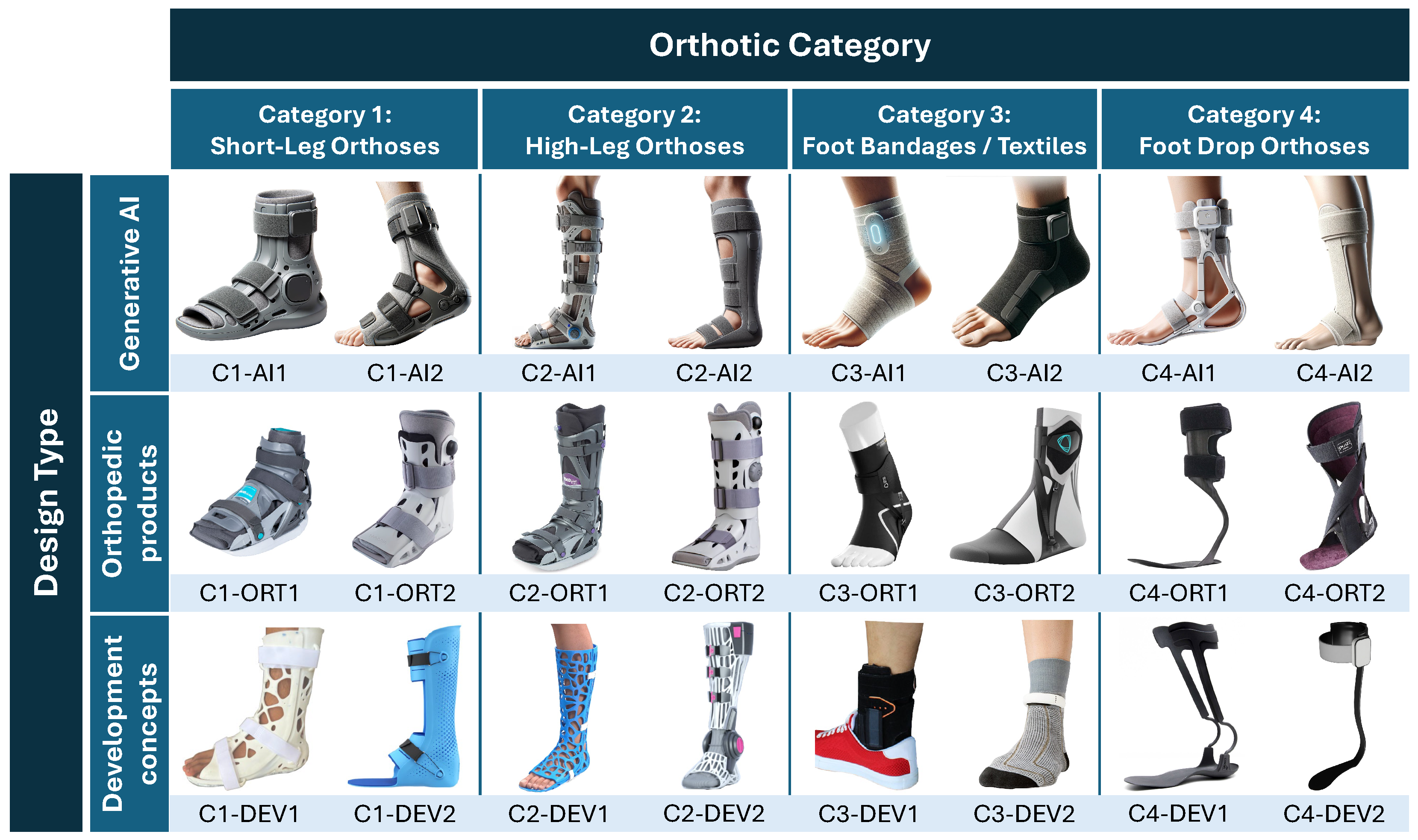
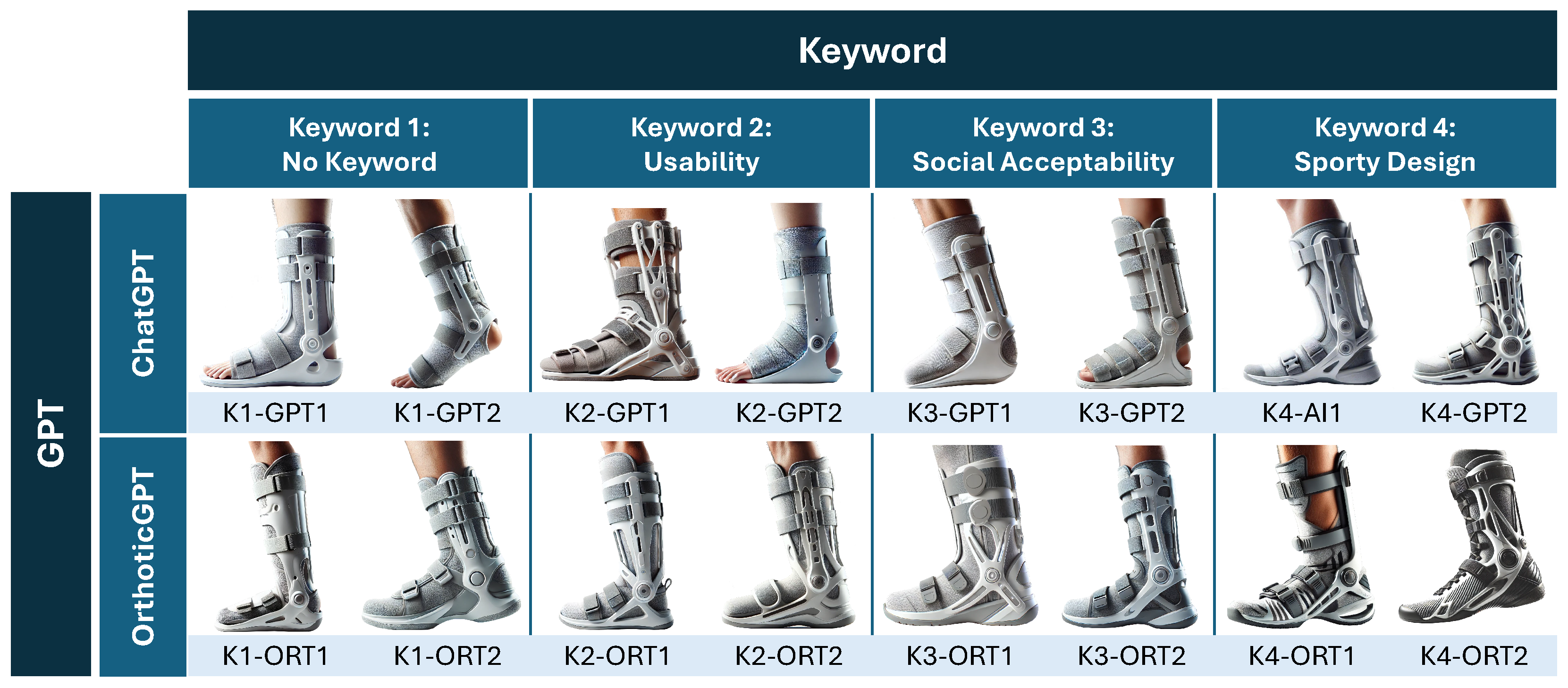
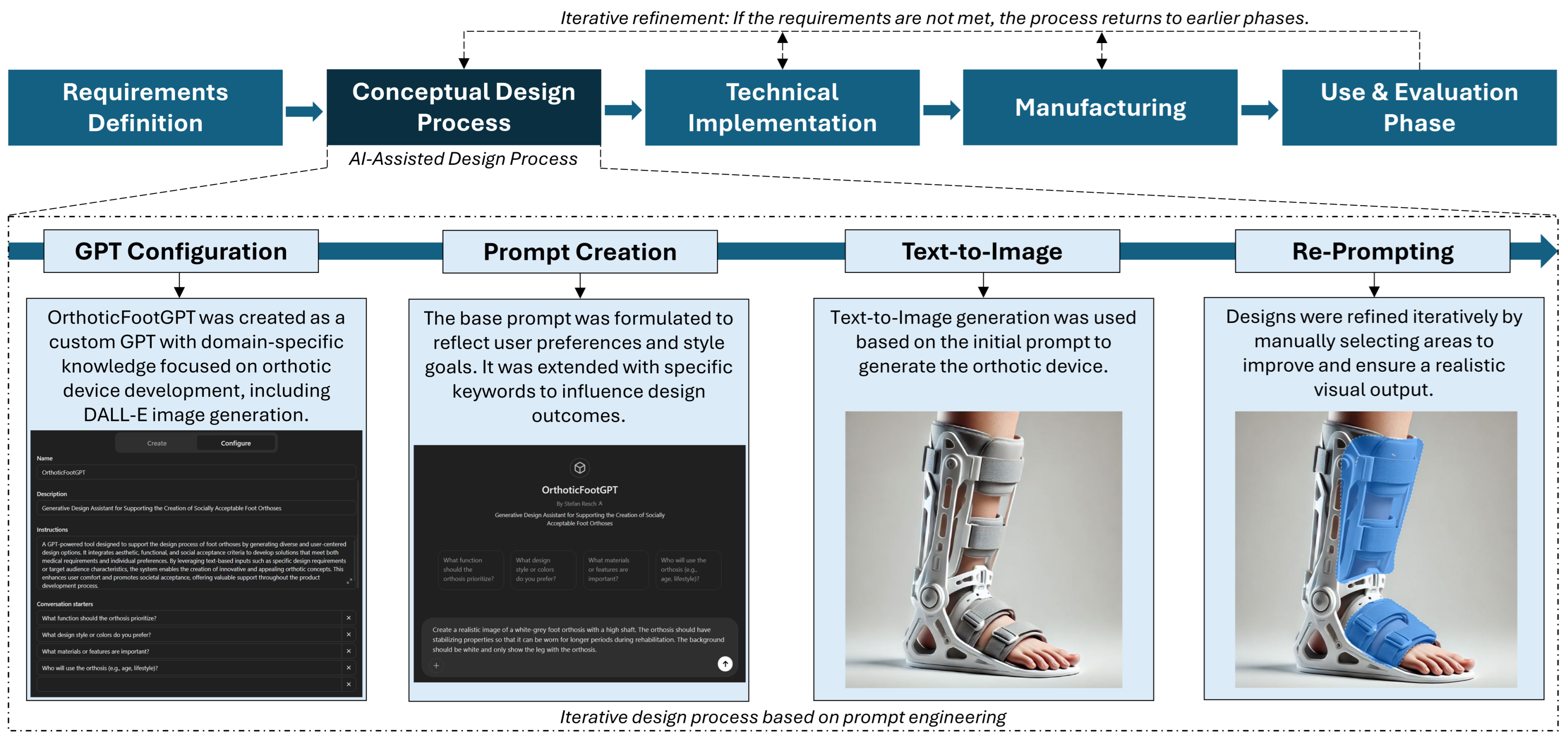


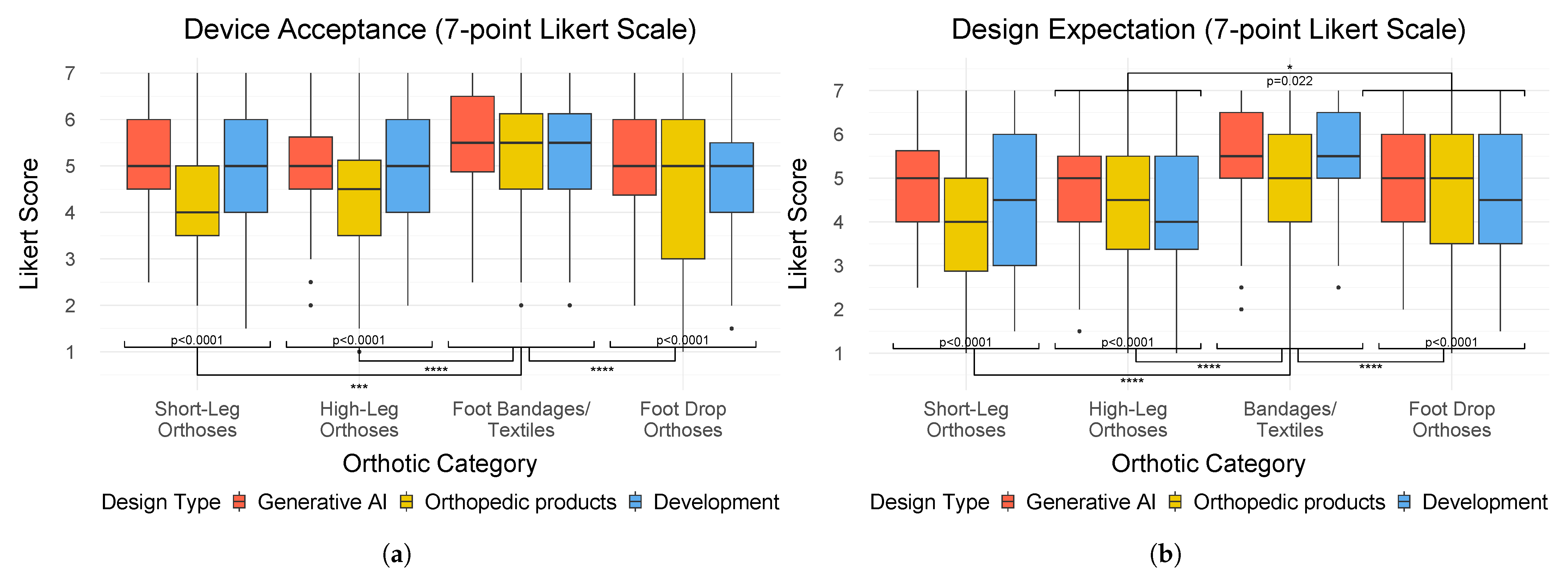
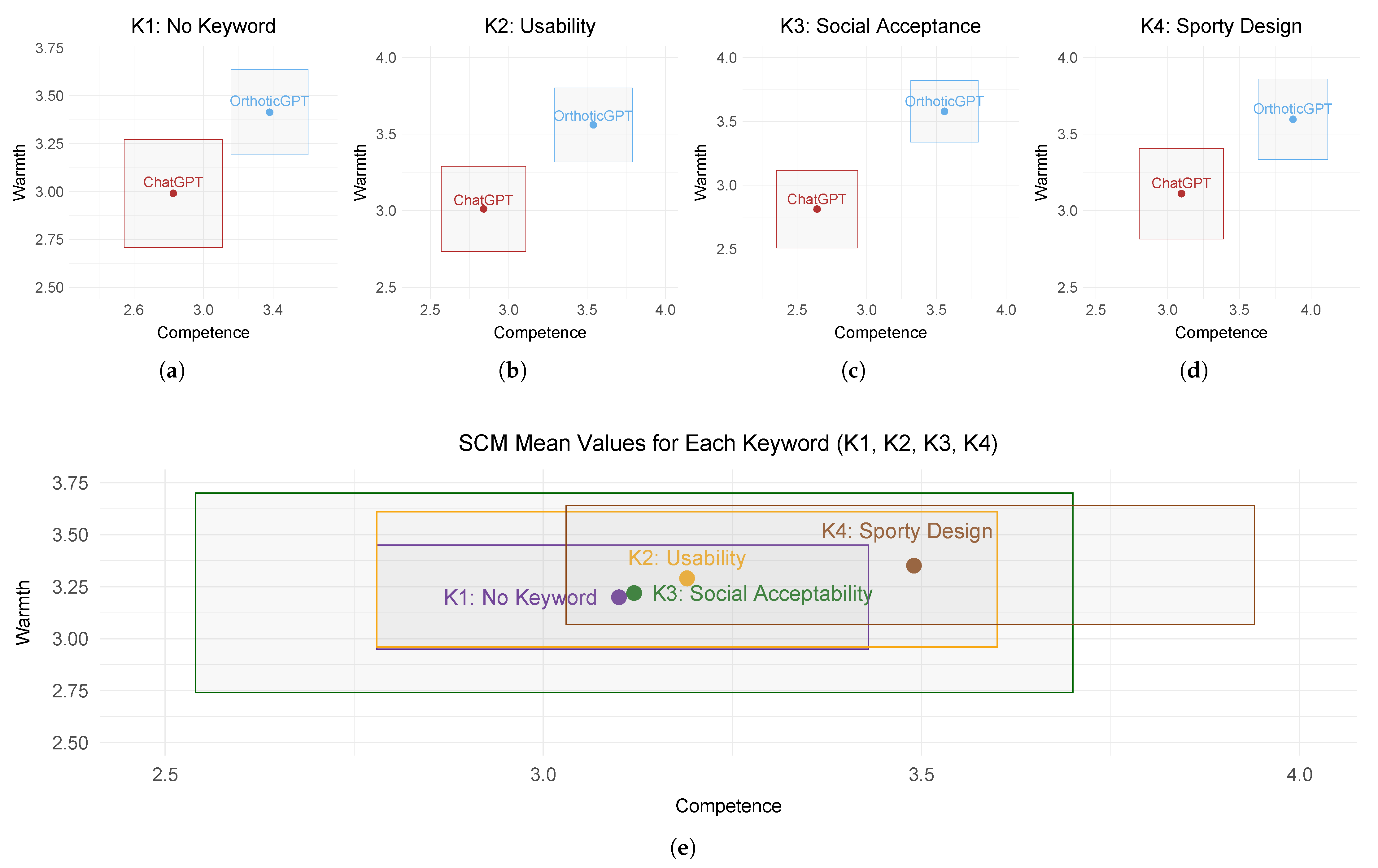
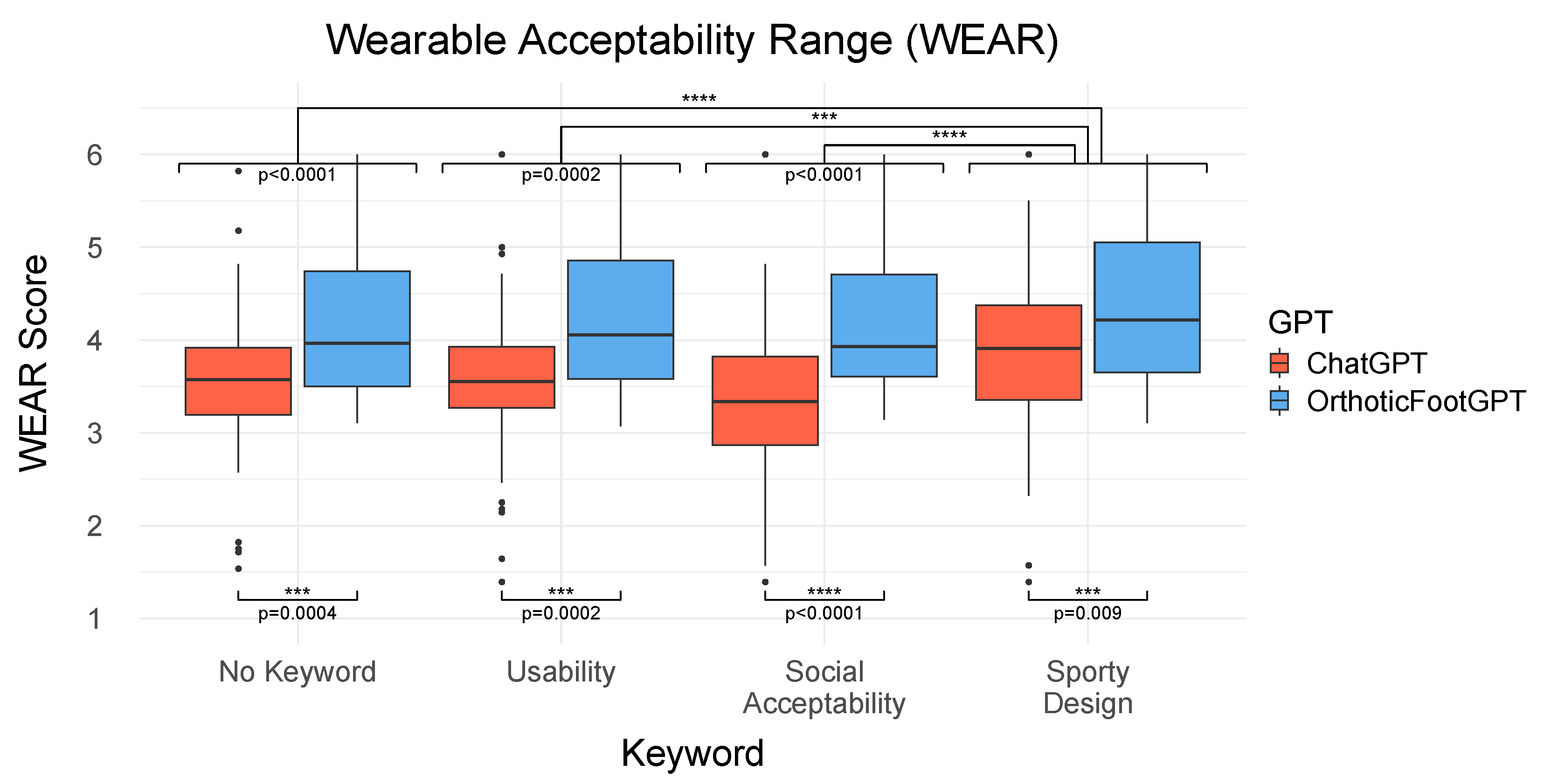
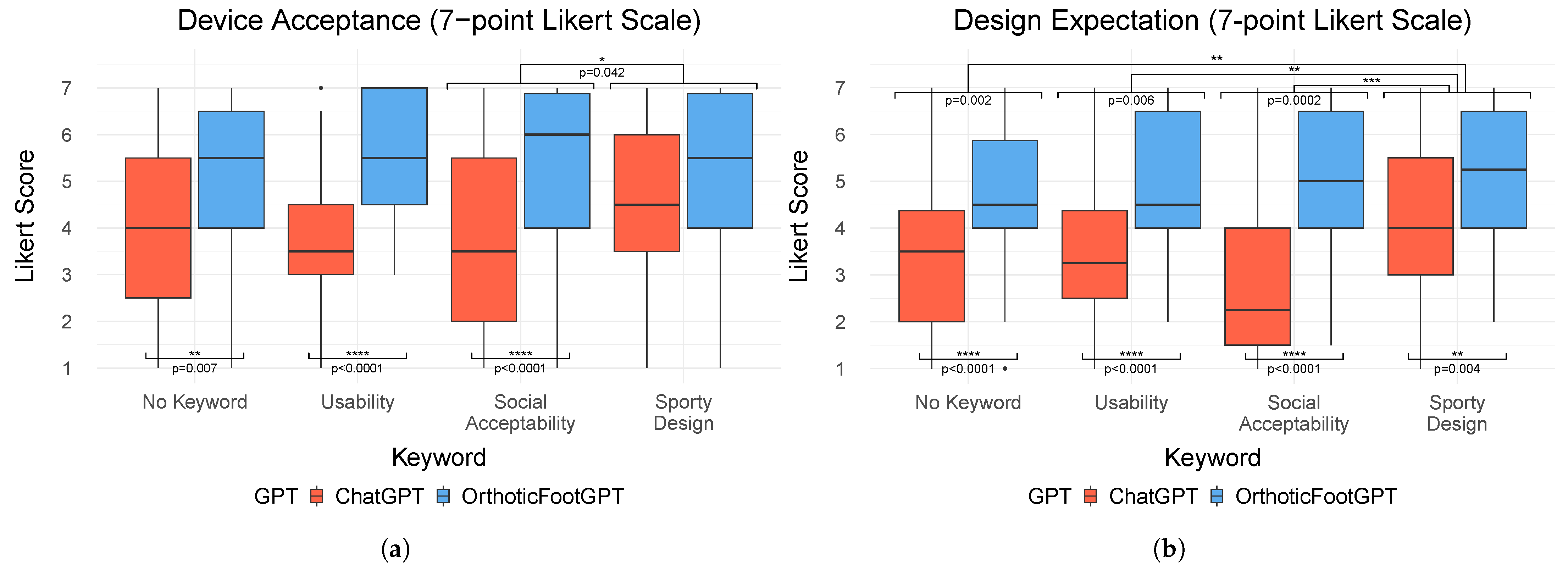
| SCM Competence | SCM Warmth | |||||||||
|---|---|---|---|---|---|---|---|---|---|---|
| Pairwise Comparisons | n1 | n2 | Stat. | p | padj. | Sig. | Stat. | p | padj. | Sig. |
| Short-Leg Orthoses—High-Leg Orthoses | 240 | 240 | 10094 | 0.057 | 0.343 | ns | 6820 | 0.612 | 1 | ns |
| Short-Leg Orthoses—Bandages/Textiles | 240 | 240 | 2997 | <0.001 | <0.001 | **** | 5401 | 0.005 | 0.03 | * |
| Short-Leg Orthoses—Foot Drop Orthoses | 240 | 240 | 5367 | <0.001 | <0.001 | **** | 6286 | 0.993 | 1 | ns |
| High-Leg Orthoses—Bandages/Textiles | 240 | 240 | 2846 | <0.001 | <0.001 | **** | 5724 | 0.002 | 0.013 | * |
| High-Leg Orthoses—Foot Drop Orthoses | 240 | 240 | 4640 | <0.001 | <0.001 | **** | 5904 | 0.360 | 1 | ns |
| Bandages/Textiles—Foot Drop Orthoses | 240 | 240 | 11938 | <0.001 | <0.001 | **** | 7802 | 0.044 | 0.265 | ns |
| Generative AI—Development | 320 | 320 | 22421 | <0.001 | <0.001 | **** | 15445 | <0.001 | <0.001 | *** |
| Generative AI—Orthopedic products | 320 | 320 | 21927 | <0.001 | <0.001 | **** | 13268 | 0.191 | 0.573 | ns |
| Development—Orthopedic products | 320 | 320 | 16596 | 0.928 | 1 | ns | 9968 | 0.003 | 0.008 | ** |
| Device Acceptance | Design Expectation | |||||||||
|---|---|---|---|---|---|---|---|---|---|---|
| Pairwise Comparisons | n1 | n2 | Stat. | p | padj. | Sig. | Stat. | p | padj. | Sig. |
| Short-Leg Orth.—High-Leg Orth. | 240 | 240 | 7901 | 0.148 | 0.888 | ns | 7804 | 0.771 | 1 | ns |
| Short-Leg Orth.—Bandages/Textiles | 240 | 240 | 4630 | <0.001 | <0.001 | **** | 2854 | <0.001 | <0.001 | **** |
| Short-Leg Orth.—Foot Drop Orth. | 240 | 240 | 7456 | 0.568 | 1 | ns | 7370 | 0.024 | 0.143 | ns |
| High-Leg Orth.—Bandages/Textiles | 240 | 240 | 3583 | <0.001 | <0.001 | **** | 3426 | <0.001 | <0.001 | **** |
| High-Leg Orth.—Foot Drop Orth. | 240 | 240 | 7032 | 0.712 | 1 | ns | 5688 | 0.004 | 0.022 | * |
| Bandages/Textiles—Foot Drop Orth. | 240 | 240 | 11454 | <0.001 | <0.001 | **** | 13938 | <0.001 | <0.001 | **** |
| Generative AI—Development | 320 | 320 | 21972 | <0.001 | <0.001 | **** | 24376 | <0.001 | <0.001 | **** |
| Generative AI—Orthopedic products | 320 | 320 | 13612 | 0.237 | 0.711 | ns | 19850 | <0.001 | <0.001 | **** |
| Development—Orthopedic products | 320 | 320 | 7405 | < 0.001 | < 0.001 | **** | 12490 | 0.004 | 0.011 | * |
| SCM Competence | SCM Warmth | |||||||||
|---|---|---|---|---|---|---|---|---|---|---|
| Pairwise Comparisons | n1 | n2 | Stat. | p | padj. | Sig. | Stat. | p | padj. | Sig. |
| No Keyword—Usability | 108 | 108 | 1482 | 0.312 | 1 | ns | 868 | 0.337 | 1 | ns |
| No Keyword—Social Acceptability | 108 | 108 | 1943 | 0.482 | 1 | ns | 1331 | 0.605 | 1 | ns |
| No Keyword—Sporty Design | 108 | 108 | 748 | <0.001 | <0.001 | **** | 850 | 0.146 | 0.876 | ns |
| Usability—Social Acceptability | 108 | 108 | 2135 | 0.075 | 0.450 | ns | 1508 | 0.186 | 1 | ns |
| Usability—Sporty Design | 108 | 108 | 725 | <0.001 | <0.001 | **** | 914 | 0.221 | 1 | ns |
| Social Acceptability—Sporty Design | 108 | 108 | 764 | <0.001 | <0.001 | **** | 854 | 0.107 | 0.642 | ns |
| No Keyword: ChatGPT—Orth.FootGPT | 54 | 54 | 942 | 0.002 | 0.002 | ** | 1135 | 0.046 | 0.046 | * |
| Usability: ChatGPT—OrthoticFootGPT | 54 | 54 | 828 | <0.001 | <0.001 | *** | 994 | 0.004 | 0.004 | ** |
| Social Accept.: ChatGPT—Orth.GPT | 54 | 54 | 777 | <0.001 | <0.001 | **** | 875 | <0.001 | <0.001 | *** |
| Sporty Design: ChatGPT—Orth.FootGPT | 54 | 54 | 830 | <0.001 | <0.001 | *** | 1069 | 0.016 | 0.016 | * |
| Device Acceptance | Design Expectation | |||||||||
|---|---|---|---|---|---|---|---|---|---|---|
| Pairwise Comparisons | n1 | n2 | Stat. | p | padj. | Sig. | Stat. | p | padj. | Sig. |
| No Keyword—Usability | 108 | 108 | 1382 | 0.548 | 1 | ns | 1545 | 0.282 | 1 | ns |
| No Keyword—Social Acceptability | 108 | 108 | 1382 | 0.199 | 1 | ns | 1833 | 0.304 | 1 | ns |
| No Keyword—Sporty Design | 108 | 108 | 1110 | 0.066 | 0.398 | ns | 1093 | <0.001 | 0.002 | ** |
| Usability—Social Acceptability | 108 | 108 | 1529 | 0.325 | 1 | ns | 2022 | 0.030 | 0.179 | ns |
| Usability—Sporty Design | 108 | 108 | 732 | 0.011 | 0.064 | ns | 934 | <0.001 | 0.006 | ** |
| Social Acceptability—Sporty Design | 108 | 108 | 1030 | 0.007 | 0.042 | * | 836 | <0.001 | <0.001 | *** |
| No Keyword: ChatGPT—Orth.FootGPT | 54 | 54 | 1022 | 0.007 | 0.007 | ** | 819 | <0.001 | <0.001 | **** |
| Usability: ChatGPT—OrthoticFootGPT | 54 | 54 | 692 | <0.001 | <0.001 | **** | 712 | <0.001 | <0.001 | **** |
| Social Accept.: ChatGPT—Orth.GPT | 54 | 54 | 744 | <0.001 | <0.001 | **** | 540 | <0.001 | <0.001 | **** |
| Sporty Design: ChatGPT—Orth.FootGPT | 54 | 54 | 1212 | 0.129 | 0.129 | ns | 997 | 0.004 | 0.004 | ** |
Disclaimer/Publisher’s Note: The statements, opinions and data contained in all publications are solely those of the individual author(s) and contributor(s) and not of MDPI and/or the editor(s). MDPI and/or the editor(s) disclaim responsibility for any injury to people or property resulting from any ideas, methods, instructions or products referred to in the content. |
© 2025 by the authors. Licensee MDPI, Basel, Switzerland. This article is an open access article distributed under the terms and conditions of the Creative Commons Attribution (CC BY) license (https://creativecommons.org/licenses/by/4.0/).
Share and Cite
Resch, S.; Schauer, J.; Schwind, V.; Völz, D.; Sanchez-Morillo, D. Improving Social Acceptance of Orthopedic Foot Orthoses Through Image-Generative AI in Product Design. Appl. Sci. 2025, 15, 4132. https://doi.org/10.3390/app15084132
Resch S, Schauer J, Schwind V, Völz D, Sanchez-Morillo D. Improving Social Acceptance of Orthopedic Foot Orthoses Through Image-Generative AI in Product Design. Applied Sciences. 2025; 15(8):4132. https://doi.org/10.3390/app15084132
Chicago/Turabian StyleResch, Stefan, Jakob Schauer, Valentin Schwind, Diana Völz, and Daniel Sanchez-Morillo. 2025. "Improving Social Acceptance of Orthopedic Foot Orthoses Through Image-Generative AI in Product Design" Applied Sciences 15, no. 8: 4132. https://doi.org/10.3390/app15084132
APA StyleResch, S., Schauer, J., Schwind, V., Völz, D., & Sanchez-Morillo, D. (2025). Improving Social Acceptance of Orthopedic Foot Orthoses Through Image-Generative AI in Product Design. Applied Sciences, 15(8), 4132. https://doi.org/10.3390/app15084132









